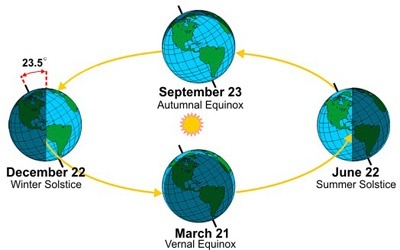
Reason for Seasons
Seasons are distinct periods during the year characterised by annually recurring weather changes. The varying intensity and duration of incoming solar radiation as Earth orbits the Sun, caused by the tilt of Earth’s rotational axis, creates these seasons. Generally, four seasons that differ by temperature – winter, spring, summer and autumn – are observed in mid and polar latitudes. In the tropics, and the subtropics, where solar radiation does not fluctuate much throughout the year, changing precipitation levels produce a dry and a wet season.
Earth rotates in a counterclockwise direction around an imaginary line, its axis, running between the North and South Poles. Because the axis is tilted at an angle of 23.5 degrees from the vertical, different parts of the planet receive solar radiation in different amounts. This tilt is the reason behind the seasons. Depending on the time of year, some latitude are tilted toward the Sun, while other regions are tilted further away. For half the year, sunlight falls most directly on the Northern Hemisphere; during the other half the Southern Hemisphere https://polska-ed.com/kupic-generic-cialis/. In the Northern Hemisphere, the north pole is tilted away from the Sun in December. Less light reaches the hemisphere then, resulting in short days and low temperatures – in other words; winter. If Earth’s axis was not tilted at all, the Poles would be cold and dark year round. Were the axis tilted more, the seasons would be more extreme.

The Seasons
- Winter: Due to colder temperatures, deciduous trees lose their leaves in winter. The same woodland scene for a typical forest in Europe is shown below for the different seasons.
- Spring: Rising temperatures and increased sunlight bring the biosphere back to life in spring. Buds and new growth appear on branches and develop into leaves and blossoms.
- Summer: Consistently warm weather encourages growth. Photosynthesis converts atmospheric carbon dioxide into sugars using energy from the Sun. Leaves open fully and seed pods form.
- Autumn: Decreased temperatures and sunlight in autumn slows biological activity, Trees withdraw chlorophyll (what makes all trees green) and nutrients from their leaves , causing them to change colour before they drop. Pods open and release seeds.
The Maltese Islands enjoy a typical Mediterranean climate. The year is made up of two very different seasons; a hot and dry summer followed by a cool and wet winter. The transition between the two is sudden, but no definite time for when this occurs exists.
Astronomical and Meteorological Seasons
The astronomical definition uses the dates of equinoxes and solstices to mark the beginning and end of the seasons:
- Spring begins on the spring equinox (normally 21st March)
- Summer begins on the summer solstice (normally 21st June)
- Autumn begins on the fall equinox (normally 21st September)
- Winter begins on the winter solstice (normally 21st December)
Because the timings of the equinoxes and solstices change each year, the length of astronomical seasons within a year and between years also vary.
According to the meteorological definition, the seasons begin on the first day of the month:
- Spring runs from March 1 to May 31st
- Summer runs from June 1 to August 31
- Autumn runs from September 1 to November 30
- Winter runs from December 1 to February 28 (February 29 in a leap year)
Seasons in the Southern Hemisphere are opposite to those in the Northern Hemisphere. Under the definition of astronomical seasons, the June solstice marks the start of summer in the Northern Hemisphere, but it is the start of winter in the Southern Hemisphere. The same rule applies for the other seasons.
In the next post we’ll be dealing with temperature.


0 comments
Write a comment